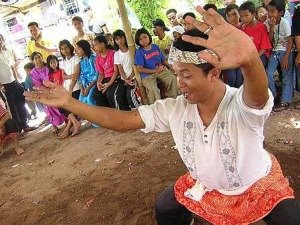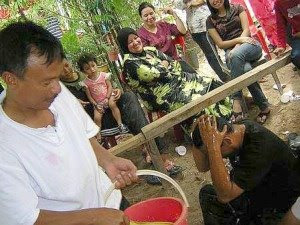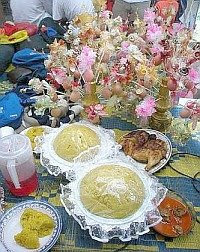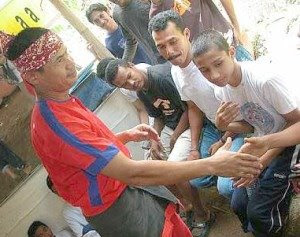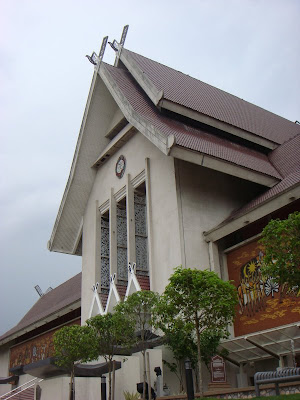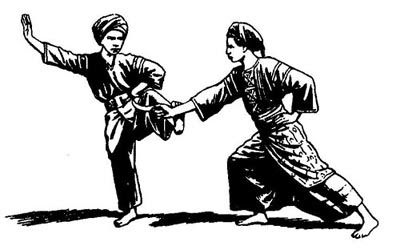At last, a Malaysian version of silat as told by Malaysians. Following is an article edited from Wikipedia about Silat from a Malaysian perspective. Most of this article is sourced from the thoughts and research of guru utama Anwar Wahab of Pertubuhan Seni Gayung Fatani Malaysia.Silat is an umbrella term for a number of martial art forms originating from the countries of the Melayu Archipelago. This art is widely known in Indonesia and Malaysia but can also be found in varying degrees among the Melayu-affiliated communities in Berunai, Singapura, Vietnam, Philipines, Thailand and Cambodia. The art has also reached Europe, and is especially popular in the Netherlands and France. There are hundreds of aliran (styles) ranging from animalistic to human styles and schools or perguruan.
Terms other than Silat are used in certain regions where it carries a specific or special meaning. For example, the term ‘gayung’ is generally used by the Melayu community in the northern region of the Melayu Peninsular. The word Gayung more specifically carries the meaning of spiritual practices in that are inherent in Silat.
The word ‘pencak’ is more normally used in Indonesia, especially by the Jawa community. It is the name for thousands of styles in and originating from Indonesia. It is believed that the word pencak originates from the word panca or manca which originates from the pronouncement of the Minangkabau which carries the meaning of a Silat curriculum with five or seven langkah or steps. The term ‘kali’ or ‘basilat’ is used by the Philippine Melayu community who developed the skill of tongkat (walking cane or staff) weaponry made of wood or cane.
TerminologyThe origins of the word ‘Silat’ itself are uncertain and most hypotheses link it to any simliar sounding word. There are two theories which are most widely accepted. One states that Silat may have originally come from sekilat which means "as (fast as) lightning". This may have been used to describe a warrior's movements and was eventually shortened to silat.
Another theory says that it comes from the term ‘Si Elat’ which is the name given to the practitioner where elat carries the meaning of efforts to confuse, deceive, trick the opponent. A similar term, ‘ilat’, means an accident, a misfortune or a calamity.
HistorySilat once played the role of forming the nation’s defence forces since the south east Asian empires of the Melayu Archipelago like Langkasuka, Gangga Negara, Champa, Funan, Pattani, Beruas, Minangkabau, Srivijaya, Majapahit, Melaka, Makassar and other kingdoms in the realm of the Melayu Archipelago.
Silat had existed in the Cham (Vietnamese Melayu) communities approximately 2000 years ago with the discovery of a copper Keris in that region and also drawings on the Borobudur temple in the Jawa region. Commanders of Champa often earned places in and was held in high esteem by the Melayu kings for possessing knowledge in silat and for being highly skilled in the art of war.
Studies show that silat had a strong presence in the Malay community for 2000 years. The empires of Funan and Champa were two kingdoms that neighbored each other in the same cluster and era. Yet, in the same century, the kingdom of Champa frequently waged wars with China while refusing to submit to China.
Silat was once placed under the protection of the palace, to form the king’s war troops. The Melayu kings encouraged princes and children of dignitaries to learn Silat and any other form of knowledge related to the necessities of war. Prominent warriors were elevated to head war troops and received rank and bestowments from the king.
In Sejarah Melayu (Malay History) it is told that Sultan Muhammad Shah had chosen a Cham official as the right hand or senior officer because the Chams possessed skill and knowledge in the administration of the kingdom. Up until the 19th century, history has shown that Silat education continuously spread and formed Melayu leaders of war fighting against colonialists, such as Mat Kilau, Bahaman, Dato’ Sago, Tok Janggut, Raja Haji, Mat Salleh and others.
The communist era saw figures such as Kiai Salleh, Kiai Osman, Kiai Samsuddin, and Haji Abbas among others. This means that Silat was not deprived of leaders who continuously invigorated and instilled the spirit of ‘love of country’ and ‘fighting to the last drop of blood’. Those mentioned above are among several names that have gone down in history that fought sincerely for their country. Their eminence has a history of and is closely related to the knowledge of Silat and other such knowledge that allowed them to become effective leaders.
In Malaysia, Silat is not only a necessity in defending one’s self, but is also the symbol of the racial persona and cultural art of the Melayu which has become accustomed to the rise and fall of the Melayu kingdoms through time and together has endured the trials and tribulations in fighting for and establishing the sovereignty of the Melayu race.
Since its disassociation with the palace, Silat did not develop in the national defence institution as it had originally, for approximately 460 years (T.M. 1511-1957). Silat returned to the countryside community and focused on the teaching of the person and the skill of self defence without using weaponry or using one’s body to face an adversary with or without weapons.
Silat only continued the training of skill in using traditional weapons such as the keris, sword, sickle, golok, lading, kelewang, tongkat (walking stick/staff), etc. In Silat, a weapon is an object that can be suited to circumstance and need. Silat also plays a role in the effort to contribute to the nation as an alternative to joining the Police or Askar Melayu (Malay soldiers). Wherever they may be, Silat is an inherent knowledge which will help them become good officers and workers who are productive.
Throughout the British occupation in the Tanah Melayu (Malay Regions/Realm), Silat continued to be left out of the national educational curriculum. Silat did not receive a place and be arranged into a subject unlike other subjects such as lessons on exercise, dance, singing, workmanship besides health education, nature education, history, English language, Melayu language and arithmetic.
Until today, Silat continues to be left out of the national educational curriculum and is only accepted as a uniform corps holding the same status or level as other forms of self defence arts from foreign countries. Although so, Silat continues to be conveyed to the community by means of the ‘gelanggang bangsal’ Silat education system carried out by Silat teachers.
AspectsSilat education continuously faces transformation in its role and meaning in the socio-culture of the Malaysian people, relevant to time and the needs of the community. Silat education focuses on the development of the person internally and externally which will enable the formation of a community that embodies discipline, morals, patriotism, self identity and citizenship which can contribute towards the development of thinking and the forces of race, religion and country.
CombatA student is first and foremost taught how to defend himself or herself. This is done in stages where the students learn the basics, such as langkah or steps (how to step, where to step) and techniques. Once the student has learned this, they are taught how to attack before being attacked, in self preservation. For that reason, Silat exponents are entrusted to ensure that their knowledge does not fall into the hands of the irresponsible, to use their knowledge confidently and to use or place their knowledge in its rightful place.
Art FormsThe seni or art form in Silat is an integral part of it as it serves to distinguish one style from another and Silat from all other martial arts. The seni aspect, also known as bunga or tari is the aesthetic form of Silat. It is portrayed through slow, graceful movements performed for aesthetic value but rooted in an essential principal of Silat, which is trickery and deception.
Through the performance of seni or bunga, an exponent is able to display his skill or hide it from the opponent in combat. In this sense, the exponent can trick the opponent into letting his guard down or committing blunders, making the opponent easier to defeat.
Despite this, the seni or art form in Silat is not rooted purely in aesthetics as there are certain styles where the seni or bunga holds its own meaning. In this case, the seni takes on a whole new dimension as it is used to practice techniques or stances that can be used in combat against an opponent.
SpiritualTo create a balanced person, Silat also focuses on the spiritual aspect. In this sense, the education aims to bring the sudent closer to his Creator and to recognise and know his God. In Silat,nowadays spirituality is largely based on the religion of Islam especially tasawwuf (knowledge of Islamic esoteric teaching). In this way, the exponent learns to repect life and his surroundings and see it as a gift from God. But in some regions the spirituality of Islam blends with the philosophies and practices of Hinduism, Buddhism, Kejawen, Animism.
Cultural Silat is essentially, a traditional martial art. It still continues to practice the values and practices carried out by the ancient warriors in their time. these practices extend to include the cultural aspects of Silat, such as clothing and music.
ClothingAll ethnics and cultures in archipelago has its owns silat's clothing. For example here, is in the Melayu tradition, especially in Malaysia. The full dress or clothing of a Melayu warrior consists of the tengkolok, baju melayu and samping tied with a bengkung.
The tengkolok is the traditional Melay headwear which is tied around the head. It has various styles, cloth types and ways of tying which is determined regionally and by status.
The baju melayu which is the traditional costume for Malay men. The style of the Baju Melayu varies according to the region.
The samping is a piece of cloth tied around the waist of an exponent and is also part of the traditional Malay dress.
The bengkung is a cloth belt or sash, tied around the waist of the exponent, on top of the samping, to show the exponent's status, level and also to secure the samping.
MusicSilat music accompanies all Silat performances. Traditional Silat music in the Malay Peninsula (Malaysia) is known as gendang baku, muzik silat baku or gendang silat baku. It consists of a gendang ibu (literally, mother drum), gendang anak (literally, child drum), a gong and the serunai which gives the music it's distinct sound.
The rhythms and melodies of the music is based on the pace of the game or Silat performance, the song itself and the region. Styles and melodies may differ from region to region. In addition to that, the type of serunai used also differs as there are two types of serunai, a longer one and a shorter one.
Styles & TechniquesSilat is a type of sport which utilizes agility in attacking and defending one’s self. This means that it is a type of traditional sport that which contends two exponents who are highly skilled in their knowledge of self defense whether with or without weaponry. Such a sport is to allow the identification of the best pesilat (silat exponent) or for performance purposes.
Thus, this sport of silat or the traditional sport of the people requires skill and agility both mentally and physically. This sport is held during leisure time, bertamat silat (finishing of one’s instruction in silat), official events, weddings or feasts which include the consumption of pulut (sticky/glutinous rice) accompanied by gendang bersilat.
This sport of silat is frequently associated with the name silat pulut or gayung pulut because each player will receive a gift in the form of a bunga telur with a small lump of pulut. This means among all others, the word Silat in Melayu socio-culture is better known as this traditional sport of the people, that is a sport that is able to uphold the ilmu kepahlawanan (values and skills of a warrior or in becoming a warrior) and the Malay art of war in the form of seni rakyat (the people’s art form).
Thus, performances of this Silat sport or Silat competitions are accompanied by the rhythm of the pergendangan silat which is now known as the muzik silat baku Malaysia or the silat baku music of Malaysia.
The regard of silat as a performing art or silat pulut follows the portrayal of Silat as a performing art or a sport/game. This meaning of Silat does not touch specifically on Silat educational services or Silat as an ilmu kepahlawanan or Melayu art of war with ties in the national defence institution.
Moreover, at that time Silat had long been disassociated from the palace. Silat did not have the space or the opportunity to develop and advance with the advancements of the defensive system alongside the developments in defensive systems in other countries around the world.
Western colonialists like the British introduced western defensive systems by incorporating the police and askar sepoi ( soldiers who were local citizens) to handle the nation’s defence which at that time, was receiving opposition from former Melayu fighters. Consequently, silat teachers were very cautious in letting Silat become apparent in the community because the colonialists had interpretations and experience in war against Melayu warriors.
Silat was not seen as an educational institution of the kepahlawanan Melayu that would contribute to the shaping of socio-culture through the traditional gelanggang bangsal education system of silat (teaching of silat in a bangsal (shed or barn) as the gelanggang [place where one learns silat]) as how the infamous religious education in the Malay community through the pondok (hut) institution was.
In the traditional Melayu community, these two institutions contributed largely in the development of the physical and spiritual or the knowledge of life and the afterlife. The combination of the gelanggang bangsal and pondok institutions had formed an albeit deprived traditional Melayu community which is able to defend its self, cultural and religious values from alternating colonialists. The education of the pendekar silat way of life which is balanced in each of the aspects of knowledge, practice and Silat skill can form a perfection of life or person.
PracticesAs Silat is a traditional martial art, there are several inherent practices tied to the practice and learning of Silat. These elements are present in Silat education and transcends style and school.
JurusA set of movements, made up of strikes, blocks and maneuvers to teach students how to combine movements, langkah, tapak and to practice them in their strikes, blocks and fighting stances (sikap pasang).
Bunga Bunga (flower) or seni is an integral part of Silat. The aesthetic movements teach the student grace, fluidity of movements and in some cases is a hidden form of practice for certain techniques. Despite this, there are, however, certain Silat styles that do not have bunga or seni.
Beladiri Beladiri or self-defence is taught by all styles of Silat.
Tempur Tempur basically means a battle, duel or fight between two pesilat but it can also be expanded to mean a battle or fight in general, disregarding the number of participants.
WeaponsAlong with the human body, Silat employs the usage of several martial arts weapons. Among the hundreds of styles are dozens of weapons. Listed here are a few examples;
- Keris: A curvy blade made from folding different types of metal together and then is washed in acid, giving the blade it's distinct look.
- Pedang/Sundang: A sword, either single or double edged.
- Parang/Golok: A machete/broadsword, commonly used in daily tasks, especially those involving farming or harvesting.
- Lembing/Seligi: A spear/javelin made of either wood or bamboo.
- Kayu/Batang: Stick, staff or rod made of bamboo, steel or wood.
- Tekpi: Three-pronged knife thought to derive from the trisula (trident)
- Kerambit: A small claw-like curved blade or dagger worn in the hair. Easily concealed and is known as a woman's weapon.
- Sabit: A sickle, commonly used in farming, cultivation and harvesting of crops.
- Tongkat: A walking stick carried by the elderly or travellers.



